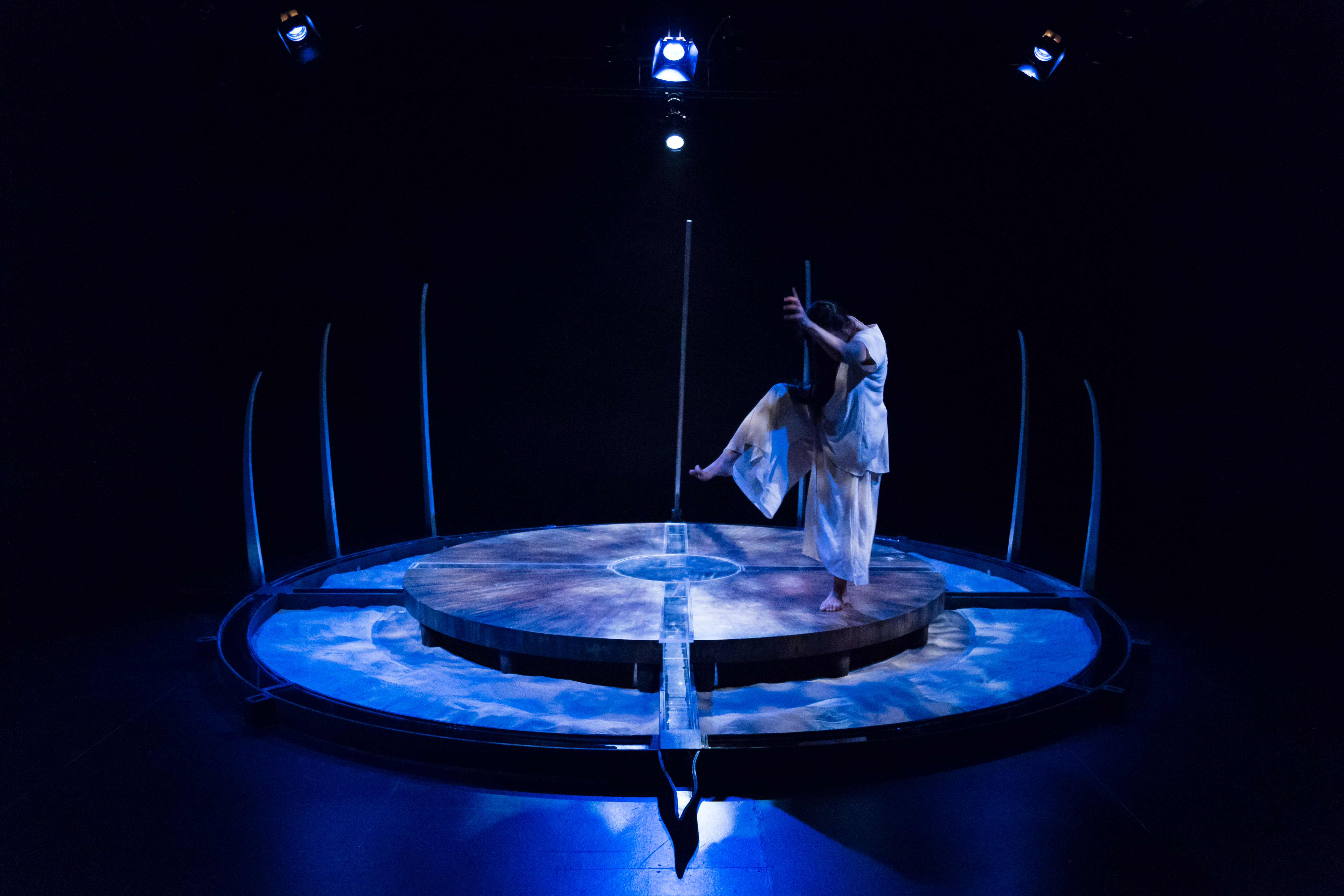Moshkamo- Finding Wolastoq Voice: East-coast voices tell their stories that convey their struggle to survive.

Mòshkamo: “ Finding Wolastoq Voice” reveals the founding cosmogony of the East Coast peoples.
This production from Theatre New Brunswick is based on a text by Natalie Sappier (Sammaqani Cocahq -the Water Spirit), a multi-disciplinary artist whose work unfolds on a frontal stage – a space in the round would have been much preferable – within the double layers of a Malaseet circle where the young woman enters the spiritual world of the Tobique First Nations to tell us her personal journey to recover her identity.
The tale advances through the double levels of the circular form lying in the centre of the performance space, referring specifically to the oral culture represented by the particular origins of the dancer and the author. Those ancestors are the resounding voices unleashed into the sky as they narrate the young woman’s tale and guide her through her journey. Directed in a most poetic and delicate manner by Thomas Morgan Jones, conceived visually by Andy Moro, a highly versatile set and lighting designer, the circular volumes surrounded by long whale-bone posts that suggest the enclosed space of living quarters, or the sweat house, are all bathed in a rich blue fluid light that engulfs this world of Mammy Wata where dancer, choreographer and singer, Aria Evans intertwines her East-Coast Mi’kmaq, African, British heritage to capture her troubled life, her own family history, and the nature of her communication with the inspiring cosmogony that reaches up to the healing Water Spirit of the river Wolastoq.
At the centre of this event, the body of the young multidisciplinary performer draws her movement, and interpretation of the text, from her multiple East Coast origins and many creative talents which help her associate closely with those traditional founding tales of her mixed cultural origins. One could go back to African tales that linger in the Caribbean diaspora which speak of the creole Mami Watah (Mammy Water), from South America, the Caribbean and everywhere where African traces persist in the “New World”. Needless to say, this is an important ethnological reference that persists across the Americas and joins the traditional tales of all the concerned peoples.
Then several dialogues take place between the voices of the ancestors and her own contemporary younger voice speaking to us in a present that also flows into her own past. She tells us how her world broke apart, the sun went out, and for ten years she could no longer communicate. The voice tells us how she was drawn to the healing water, how the fish creatures fascinated her and drew her to their realm. She loved the water but the sun left and she remained alone in the darkness for so long that she forgot her identity. Then younger voices tell us how the young Wolastoq girl was abused by her father and other older men while forgetting the painful memories of her mother whom she grew up to hate because she did not know her mother.
Then the spirits of the forest taught her to find an intimate relationship with nature and she was reborn in the water, transformed into a silvery salmon, healed by the stillness of the river. Also her experiences with a traditional sweat lodge, listening to her Wolastoq sister and asking questions to those chanting voices as all of nature converged on her world, brought her out of the darkness.
A bear, an image of strength, came to her in her dreams, as the dancer bends over and moves on all fours, expressing her encounter with this strong animal as she feared he would attack her. However, the bear transformed her gaze, put love in her eyes and gave her strength not to hurt but to heal. She finally reconciled with the world as she broke out of her isolation, reunited with her mother, forgave her father after the pain he caused them all and was accepted by her ancestors who had been watching over her from the sky .
The concentric circles seemed to capture the different spiritual levels of invisible voices that spoke to her as they guided her journey and the shifting colours that bathed the circles changed the moods of the dancer as she captured the multiple levels of perception that seeped into this dense but beautiful text which had to be spoken, not read. Here was the perfect example of the orality accompanied by sounds ande instruments that define this form of performance that incarnates spiritual communication with the invisible world that is always so clearly present.
I found the dancer’s body was not always easy to read and the intertwining of the corporeal performance with such a rich spoken text that forced us to listen intently, at times gave the impression that the moving body produced an overflowing of information sometimes difficult to capture. However, the fluid flowing, and beautiful blue of the warm river drew us deeply into that watery world and we followed her journey without the slightest hesitation.
It is becoming clear that after seeing several Mòshkamo events, one can start to piece together references, visual experiences , cosmogonies associated with the first people’s world that help us recognize a richly textured pre-colonial history , of which most of the non-native people in the audience are unaware. This festival has the great merit of drawing attention to the peoples who share our geopolitical space, the peoples whose histories and related cultural contexts (including their languages) have been obliterated by warped colonial thinking of the past which has never taken these cultures seriously. Our shameful ignorance must be corrected.
Finding Wolastoq Voice
Text Natalie Sappier (Samagani Cocahq)
Directed and staged by Thomas Moran Jones,
Set and lighting design by Andy Moro
Featuring Aria Evans